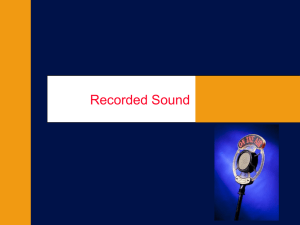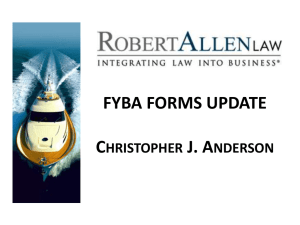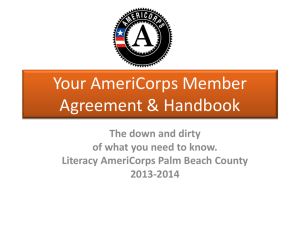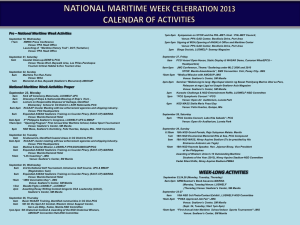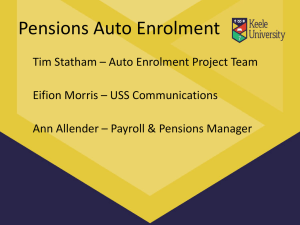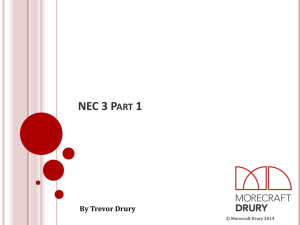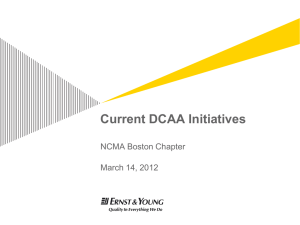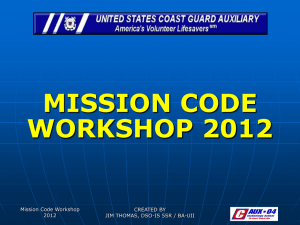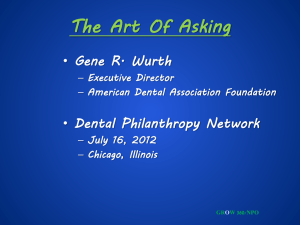Longshore Act or Jones Act? The Uncertainty Zone
advertisement
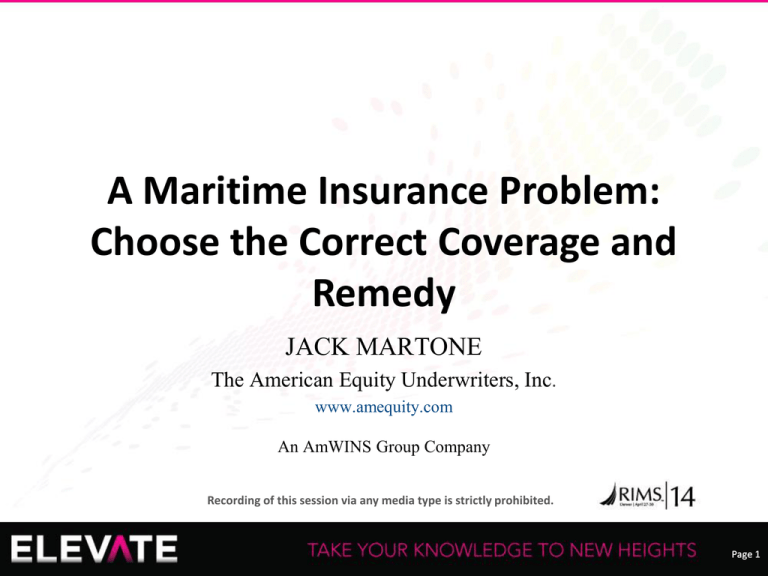
A Maritime Insurance Problem: Choose the Correct Coverage and Remedy JACK MARTONE The American Equity Underwriters, Inc. www.amequity.com An AmWINS Group Company Recording of this session via any media type is strictly prohibited. Page 1 • Jack Martone Senior Vice President The American Equity Underwriters, Inc. Jack Martone, former Acting Director, Division of Longshore and Harbor Workers’ Compensation, and Chief, Branch of Financial Management, Insurance and Assessment at the United States Department of Labor, joined AEU in 2006 as Senior Vice President. During Jack’s 27 years with the Department of Labor, he directed the licensing and regulation of insurance carriers and self insured employers under the Longshore and Harbor Workers Compensation Act and extensions, the Defense Base Act, the Outer Continental Shelf Lands Act, and the Nonappropriated Fund Instrumentalities Act. He also administered the Special Fund created by section 44 of the Longshore Act and billed and collected the annual industry assessment. AEU is one of the top two writers of USL&H coverage worldwide. Recording of this session via any media type is strictly prohibited. Page 2 What to Expect After attending this session you should be able to: Distinguish exposure under the Longshore and Harbor Workers’ Compensation Act from Jones Act exposure, Understand the insurance requirements of both exposures, and The consequences of lack of proper insurance. Recording of this session via any media type is strictly prohibited. Page 3 Confusion in Two Acts • My company (AEU) writes workers’ compensation insurance under the Longshore and Harbor Workers’ Compensation Act. The Longshore Act excludes Jones Act seamen from coverage • The Jones Act only covers seamen (crewmembers of a vessel) • The cost of coverage is based primarily on the exposed payroll • Underwriters struggle constantly with issues of payroll that can go either way because of coverage uncertainty between the two Acts Recording of this session via any media type is strictly prohibited. Page 4 Jones Act • The Jones Act is a cabotage law and liability remedy • Cabotage – “A vessel may not provide any part of the transportation of merchandise by water, or by land or water, between points in the U.S. to which the coastwise laws apply, either directly or via a foreign port ….”, generally unless the vessel is built (and rebuilt) in the U.S., crewed by Americans, and owned by Americans.” 46 U.S.C. 55102 • Applies to U.S. navigable waters and points on the outer continental shelf of the U.S. • The Jones Act is protectionist and also a key element in national defense – the nation needs a domestic shipbuilding capacity and a trained merchant marine Recording of this session via any media type is strictly prohibited. Page 5 Longshore and Harbor Workers’ Compensation Act The Longshore Act (33 U.S.C. 901 ff.) is a federal workers’ compensation law that covers maritime workers It was passed in 1927, and has been amended several times, most significantly in 1972 and 1984, and most recently on February 17, 2009, with regard to recreational boat building Recording of this session via any media type is strictly prohibited. Page 6 Jones Act • The Jones Act is a liability remedy for seamen. • Section 27 of the Merchant Marine Act of 1920 (Jones Act) (46 U.S.C. 30104) was enacted in response to the U.S. Supreme Court’s decision in The Osceola, 189 U.S. 158 (1903) • The Court in The Osceola had summarized seamen’s rights under the general maritime law. These rights (unseaworthiness, maintenance and cure) did not include a tort remedy for negligence against the vessel owner • The Jones Act extended to seamen the rights given to railroad workers by the Federal Employers Liability Act (FELA) in 1908 Recording of this session via any media type is strictly prohibited. Page 7 Jones Act “Any seaman who shall suffer personal injury in the course of his employment may, at his election, maintain an action for damages at law, with the right of trial by jury, … and in the case of the death of any seaman as a result of any such personal injury the personal representative of such seaman may maintain an action for damages at law with the right of trial by jury ….” Recording of this session via any media type is strictly prohibited. Page 8 Remedial Statutes • Both the Longshore Act and the Jones Act arose out of and were part of the sweeping legislation on behalf of workers enacted during the Progressive Era in the U.S. (1890-1920) • These were considered to be “remedial” laws, addressing abuses and providing protection to workers following the Industrial Age • They are liberally interpreted and are still referred to today as remedial statutes by the courts • Seamen are emphatically “wards of the court” • The fact that both mutually exclusive laws are “remedial” and to be liberally construed to favor coverage complicates matters Recording of this session via any media type is strictly prohibited. Page 9 The Defense Base Act The Defense Base Act (42 U.S.C. 1651 ff.) is a workers’ compensation law that extends the benefits of the Longshore Act to employees outside of the continental U.S. under certain circumstances Recording of this session via any media type is strictly prohibited. Page 10 The Defense Base Act The DBA covers the following: 1. All employees working overseas for private employers on U.S. military bases or an any lands used by the U.S. for military purposes in any Territory or possession; 2. All employees working on public works contract with any U.S. Government agency outside the continental U.S.; Recording of this session via any media type is strictly prohibited. Page 11 The Defense Base Act 3. All employees working on contracts approved or funded by the U.S. under the Foreign Assistance Act outside the U.S.; 4. All employees working for American employers providing welfare or similar services outside the U.S. for the benefit of the armed forces Recording of this session via any media type is strictly prohibited. Page 12 The Outer Continental Shelf Lands Act The OCSLA (43 U.S.C. 1331 ff.) was enacted in 1953 for the purpose of establishing a body of law governing oil and gas activities on the outer continental shelf of the United States Recording of this session via any media type is strictly prohibited. Page 13 The Outer Continental Shelf Lands Act Longshore Act benefits are payable for injuries or deaths occurring as the result of operations conducted on the outer Continental Shelf for the purpose of exploring for, developing, removing, or transporting by pipeline the natural resources, or involving rights to the natural resources, of the subsoil and seabed of the outer Continental Shelf Recording of this session via any media type is strictly prohibited. Page 14 Outer Continental Shelf Lands Act What is the OCS? All submerged lands under the jurisdiction and control of the U.S. lying seaward and outside the area of lands beneath navigable waters as defined in the Submerged Lands Act (43 U.S.C. 1301 ff.) Recording of this session via any media type is strictly prohibited. Page 15 An Insurance Problem • It is often difficult to distinguish liability under the Jones Act and the general maritime law from workers’ compensation liability under the Longshore and Harbor Workers’ Compensation Act • The Jones Act covers crewmembers of vessels and the Longshore Act covers land based maritime workers • The two laws are mutually exclusive by design but in practice coverage often seems to overlap (and they are both “remedial” laws) Recording of this session via any media type is strictly prohibited. Page 16 Two Laws • Vessel owners must insure their liability for the illness, injury, or death of crewmembers under the Jones Act and the general maritime law (the judicially created, international remedies of maintenance and cure, unseaworthiness, wrongful death and retaliatory discharge available to seamen) • Maritime employers must provide workers’ compensation insurance under the Longshore and Harbor Workers’ Compensation Act for employees who work on or around vessels but who are not crewmembers Recording of this session via any media type is strictly prohibited. Page 17 Two remedies • Southwest Marine, Inc. v. Gizoni, 502 U.S. 81 (1991) • Supreme Court affirms Ninth Circuit • An injured maritime worker can accept payments under the Longshore Act while filing a Jones Act lawsuit – in fact, the Longshore Act contemplates this: Section 913(d) – time for filing a claim tolled while Jones Act suit is pending, and Section 903(e) – employer gets a Longshore Act credit for any amounts paid under the Jones Act • the injured worker can initially go for both mutually exclusive remedies with entitlement not decided until final adjudication Recording of this session via any media type is strictly prohibited. Page 18 Coverage - Longshore Act • The Longshore Act states that, “The term ‘employee’ means any person engaged in maritime employment, including any longshoreman or other person engaged in longshoring operations, and any harbor-worker including a ship repairman, shipbuilder, and ship-breaker….” (33 U.S.C. Section 902(3)) This is the status test for coverage, and it covers hundreds of occupations • The Longshore Act expressly excludes from coverage “a master or member of a crew of any vessel”. (33 U.S.C. Section 902(3)(G)) Recording of this session via any media type is strictly prohibited. Page 19 Coverage - Longshore Act • The Longshore Act states that, “… compensation shall be payable under this Act in respect of disability or death of an employee, but only if the disability or death results from an injury occurring upon the navigable waters of the United States (including any adjoining pier, wharf, dry dock, terminal, building way, marine railway, or other adjoining area customarily used by an employer in loading, unloading, repairing, dismantling, or building a vessel).” (33 U.S.C. Section 903(a)) • This is the situs test for coverage Recording of this session via any media type is strictly prohibited. Page 20 Terms not Defined • • The Longshore Act does not define key terms such as “maritime employment”, “harbor worker”, “navigable waters”, and “other adjoining area”; the Jones Act does not define who is a “seaman”. And neither law defines a “vessel” The courts try to define the geographic and occupational tests for Longshore Act coverage (status and situs) and the Jones Act’s occupational, status based test for who is a member of a crew of a vessel on a case by case basis Recording of this session via any media type is strictly prohibited. Page 21 Uncertainty Zone The case law has established that a seaman under the Jones Act is the same as the Longshore Act’s “master or member of a crew of any vessel”. It has also been determined that a “vessel” under the Longshore Act is the same as a “vessel” under the Jones Act. But the courts recognize an “Uncertainty Zone” where many occupations seem to fit the coverage requirements of both Acts. And we still have not adequately defined a vessel Recording of this session via any media type is strictly prohibited. Page 22 Longshore Act Insurance Requirement The Longshore Act in Section 932 requires that every maritime employer obtain Longshore Act coverage from an insurance carrier authorized by the U.S. Department of Labor, or obtain the Department’s authorization to self-insure. If an employer fails to meet this insurance requirement, the following provisions apply: Recording of this session via any media type is strictly prohibited. Page 23 Section 905(a) “If an employer fails to secure payment of compensation as required by this Act, an injured employee, or his legal representative in case death results from the injury, may elect to claim compensation under the Act, or to maintain an action at law or in admiralty for damages on account of such injury or death. In such action the defendant may not plead as a defense that the injury was caused by the negligence of a fellow servant, or that the employee assumed the risk of his employment, or that the injury was due to the contributory negligence of the employee.” Recording of this session via any media type is strictly prohibited. Page 24 Section 938(a) • “Any employer required to secure the payment of compensation under this Act who fails to secure such compensation shall be guilty of a misdemeanor and, upon conviction thereof, shall be punished by a fine of not more than $10,000, or by imprisonment for not more than one year, or by both such fine and imprisonment.” • The corporate President, Secretary, and Treasurer are also liable Recording of this session via any media type is strictly prohibited. Page 25 Section 938(a) “… where such employer is a corporation, the president, secretary, and treasurer thereof shall be also severally personally liable, jointly with such corporation, for any compensation or other benefit which may accrue under the said Act ….” Recording of this session via any media type is strictly prohibited. Page 26 Jones Act Insurance • Jones Act insurance coverage is liability coverage usually provided in the vessel owner’s protection and indemnity policy, or by adding the maritime coverage endorsement to the workers’ compensation and employer’s liability policy, or by adding a marine liability endorsement to the commercial general liability policy • Given the potential size of jury verdicts, not to mention the expense of defending against a Jones Act lawsuit, the vessel owner must have adequate maritime liability insurance coverage Recording of this session via any media type is strictly prohibited. Page 27 Uncertainty Zone “Thus, despite our continued insistence that a Jones Act ‘seaman’ and a ‘crew member’ excluded from the Longshore Act are one and the same (in other words that the statutes are mutually exclusive) we recognize that in a practical sense, a ‘zone of uncertainty’ inevitably connects the two Acts.” McDermott inc. v. Boudreaux, 679 F. 2nd 452 (5th Cir. 1982) Recording of this session via any media type is strictly prohibited. Page 28 Longshore Coverage The Longshore Act has both a status (occupational) and a situs (geographical/functional) test for coverage. An employee’s occupation must be “integral” to the unloading/loading of cargo or shipbuilding/ship repair (status) and he must be working over the navigable waters of the U.S., on an “enumerated” site, or in an adjoining area customarily used by an employer for covered activity (situs). Coverage includes a wide range of occupations, including maintenance and repair workers, construction workers, contractors of all kinds, and everyone whose work requires them to be on the navigable waters Recording of this session via any media type is strictly prohibited. Page 29 Jones Act Coverage The Jones Act covers crewmembers of vessels What Is a Crewmember? The Jones Act uses an occupational test, related to the worker’s relationship to a vessel. The worker’s duties must contribute to the function of the vessel or to the accomplishment of its mission, and the worker must have an employment connection to a vessel in navigation, or to an identifiable group of vessels under common ownership, that is substantial in terms of both duration and nature (Chandris inc. v. Latsis, 515 U.S. 347 (1995) Recording of this session via any media type is strictly prohibited. Page 30 Coverage Courts use a 30% rule of thumb in reference to the substantial duration measure in Jones Act cases. A worker who spends less than 30% of his work time on board a vessel is probably not a Jones Act seaman, but this test is not conclusive Recording of this session via any media type is strictly prohibited. Page 31 Coverage • • • • • The crewmember must be “injured in the course of employment” Common law principle – while furthering the employer’s (or the ship’s) business Often cited test – does the employee act entirely of his own impulse, for his own amusement, and for no purpose of or benefit to the employer? Cited in Amanda Beech v. Hercules Drilling Company, LLC, 691 F.3d 566 (5th Cir. 2012) – deceased accidentally, fatally shot by fellow crewmember while a handgun was being displayed on a jack-up drilling rig. This was not “in the course of employment” U.S. Supreme Court has denied review Recording of this session via any media type is strictly prohibited. Page 32 Coverage • What Is a Vessel? Stewart v. Dutra Construction Co., 543 U.S. 481 (2005) – Super Scoop dredge- the Supreme Court adopted a very broad definition of vessel, applying 1 U.S.C. Section 3: “The word ‘vessel’ includes every description of watercraft or other artificial contrivance used, or capable of being used, as a means of transportation on water.” • Anything that floats? Recording of this session via any media type is strictly prohibited. Page 33 Coverage • Lozman v. The City of Riviera Beach, Florida, (133 S. Ct.735 (2013)) decided on January 15, 2013, involved a floating home that the Eleventh Circuit Court of Appeals had decided was a vessel • The Supreme Court agreed to hear the appeal, raising expectations, or hopes, that an improved vessel status test would be forthcoming • The Court took a close look at the language of 1 U.S.C. Section 3, which defines a vessel as “every description of watercraft or other artificial contrivance used, or capable of being used, as a means of transportation on water.” Recording of this session via any media type is strictly prohibited. Page 34 Coverage • In Lozman, the Supreme Court determined that, “a reasonable observer, looking to the home’s physical characteristics and activities, would not consider it to be designed to any practical degree for carrying people or things on water.” • The Court acknowledged that its “reasonable observer” test “is neither perfectly precise nor always determinative. Nonetheless, we believe the criterion we have used, taken together with our example of its application here, should offer guidance in a significant number of borderline cases. Moreover, borderline cases will always exist.” Recording of this session via any media type is strictly prohibited. Page 35 Coverage Tests: • Longshore Act – Situs and Status, worker must meet both separately • Jones Act – Crewmember – Chandris v. Latsis Vessel – Lozman – Reasonable observer, practical not theoretical, 1 U.S.C. Section 3 In the Course of Employment Recording of this session via any media type is strictly prohibited. Page 36 Remedies • The choice of remedy is with the injured worker • The Longshore Act is a workers’ compensation law providing no fault, prompt payment of statutory benefits and medical treatment. It is designed to be predictable for the employer and quick for the worker. It is administered by the U.S. Department of Labor, which offers levels of informal dispute resolution services and formal adjudication with judicial review Recording of this session via any media type is strictly prohibited. Page 37 Remedies • The Jones Act provides a negligence remedy, enforced by filing a lawsuit with the right to a jury trial. The potential recovery can far exceed the limit of workers’ compensation benefits. Factors for recovery include pain and suffering, past and future wage loss, past and future fringe benefit value, medical costs, loss of quality of life, and a host of other damage measures • There is no government agency involved. The remedy is with the courts, and the courts afford favorable treatment to seamen Recording of this session via any media type is strictly prohibited. Page 38 Remedies Fees for the successful claimant’s attorney provide additional motivation in choice of remedies. Under the Longshore Act an attorney’s fee must be approved by the adjudicator at the U.S. Department of Labor, based on a detailed fee request listing services rendered and the amount of time spent for each component of work as well as the hourly rate charged. Under the Jones Act, attorney’s fees typically amount to 33% to 40% (plus costs) of the total recovery, depending on whether the matter is settled or goes to a judgment Recording of this session via any media type is strictly prohibited. Page 39 Example One A Cargo Operations Manager, employed by a terminal operator which is also the owner of a fleet of barges, is injured when he falls while climbing a ladder from the dock to one of the barges. His duties require him to spend about 75% of his time on board the employer’s barges, supervising the loading of cargo Should this worker be covered under the Longshore Act or under the Jones Act (the courts use a 30% rule of thumb – if the worker spends less than 30% of his work time on board a vessel, then he is probably not a Jones Act seaman)? Recording of this session via any media type is strictly prohibited. Page 40 Example One • In favor of Jones Act coverage is the fact that the employee spent 75% of his working time on board the employer’s vessels and was injured on one of the barges. • In favor of Longshore Act coverage is the occupational analysis. The total circumstances of the worker’s duties must be considered. This employee’s primary duty involved the supervision of loading and unloading cargo. This is land based work. Recording of this session via any media type is strictly prohibited. Page 41 Example One In this case, the worker was determined to be a Longshore Act land based worker by DOL’s Benefits Review Board Recording of this session via any media type is strictly prohibited. Page 42 Example Two • The employer operates a barge repair facility and owns two tugboats. The employee works as a welder/fitter, and also as a trainee mate/deckhand on the tug • The employee died while working on board one of the vessels when he fell overboard and drowned • The widow filed a Jones Act lawsuit, which she resolved with the employer for a cash settlement. She then filed a claim for widow’s benefits under the Longshore Act • Outcome? Recording of this session via any media type is strictly prohibited. Page 43 Example Two • After a detailed analysis of the time the employee spent in each of his job categories, to determine whether he performed a substantial part of his duties on board a vessel so that he could qualify as a seaman, the U.S. Department of Labor’s Administrative Law Judge found that the worker spent most of his time as a welder. The widow was awarded benefits under the Longshore Act • The widow was paid under two mutually exclusive statutes. There was no double recovery, however, since the employer is entitled to a credit for its Jones Act settlement payment against its Longshore Act liability under Section 903(e) • But the employer did have to bear the expense of defending against both claims Recording of this session via any media type is strictly prohibited. Page 44 Example Three • An ironworker works for a bridge building contractor. He spends a factually disputed amount of his time working from a derrick crane barge erecting work platforms around bridge pilings and setting bridge girders • He also has some factually disputed responsibilities assisting in the navigation and maintenance of the barge • He is land based in that he travels to and from the barge from his home each workday Recording of this session via any media type is strictly prohibited. Page 45 Example Three The crane barge is a vessel, so is the ironworker a member of the crew? Does he have a Jones Act remedy, or is he a land based worker with a workers’ compensation remedy, either Longshore Act or state act? Recording of this session via any media type is strictly prohibited. Page 46 Example Three • Remember the Chandris test • Part One – assist in the mission or function of the vessel, • Part Two – substantial employment connection to a vessel in terms of both nature and duration • If he’s over 30% of his work time on the barge, he’s got a good claim for Jones Act seaman status • These construction worker, floating work platform claims go both ways Recording of this session via any media type is strictly prohibited. Page 47 Conclusion • There are several key issues in this jurisprudence that are unresolved, or that are the subject of conflicts among the federal circuits • Issues such as “in the course of employment”, the new “reasonable observer” test from Lozman, the factual disputes under the Chandris crewmember test, the many mixed duties employees, the wide variety of construction platforms and oil and gas platforms and the persistent questions involved in identifying Longshore Act coverage all put the maritime employer in a difficult position Recording of this session via any media type is strictly prohibited. Page 48 Questions? Thank you, and Check out AEU’s Longshore Blog at amequity.com jack.martone@amequity.com Recording of this session via any media type is strictly prohibited. Page 49 A Maritime Insurance Problem A Risk Manager’s Perspective David S. Hershey, CPCU, CRM, CRIS, CPSR, AMIM, ARM, MLIS Recording of this session via any media type is strictly prohibited. Page 50 A Maritime Insurance Problem A Risk Manager’s Perspective Disclaimer: The views and opinions expressed here are not those of Lexa International, and are not intended to endorse, promote, or discredit any particular insurer or their practice(s). Recording of this session via any media type is strictly prohibited. Page 51 A Maritime Insurance Problem A Risk Manager’s Perspective Quick Profile: - 10 + Countries, 25+ States - $5.5B Annual Sales (2013) - Petroleum wholesale and distribution, 15 terminals with 9.1 million barrels of refined products and other liquid materials capacity. - Municipal water treatment equipment mfg. (international) treats 7T+ gal/year Recording of this session via any media type is strictly prohibited. Page 52 A Maritime Insurance Problem A Risk Manager’s Perspective Quick Profile (cont’d): - Residential water treatment systems mfg. and distribution (international) - Medical device manufacturing and distribution (international) - Razors, machine knives, Syringes, hand held cutting tools - Medical device mfg. knee replacements Recording of this session via any media type is strictly prohibited. Page 53 A Maritime Insurance Problem A Risk Manager’s Perspective Quick Profile (cont’d): - Lumber recycling (international) - Mount Vernon, Truman Library, home of James Madison - College student housing (regional) - Business Application Software Development (Italy/USA based) Recording of this session via any media type is strictly prohibited. Page 54 A Maritime Insurance Problem A Risk Manager’s Perspective Eligibility Conflicts for Fixed Site Employers: - USL&H - Jones Act - State Act Recording of this session via any media type is strictly prohibited. Page 55 A Maritime Insurance Problem A Risk Manager’s Perspective USL&H Territory/Jurisdiction - outside the fence - inside the fence Homeland Security USCG Recording of this session via any media type is strictly prohibited. Page 56 A Maritime Insurance Problem A Risk Manager’s Perspective Coverage - Jones Act - USL&H - if any - Premium Audit - What if Governing Classification is not “F” Rated? - Don’t forget about the A/P Recording of this session via any media type is strictly prohibited. Page 57 A Maritime Insurance Problem A Risk Manager’s Perspective Concerns about claimants on the same premises - Federal benefits, State benefits - Similar claim pattern - Dealing with often substantial benefits differential among employees - Third party over actions and the concern to be sure you have Wo5 and A/I on vendor contracts Recording of this session via any media type is strictly prohibited. Page 58 A Maritime Insurance Problem A Risk Manager’s Perspective Thank you David S. Hershey Recording of this session via any media type is strictly prohibited. Page 59



